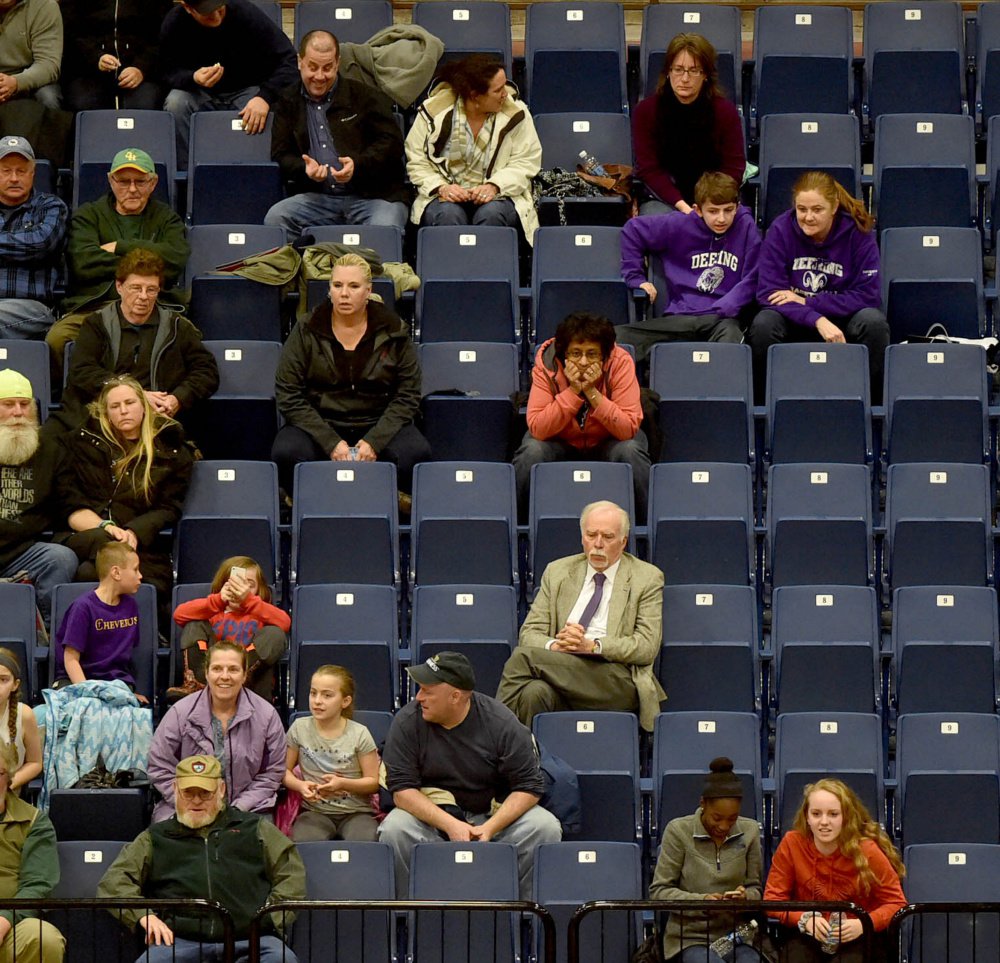When the Portland and South Portland High boys’ basketball teams faced off for the 2016 Class AA state championship, nearly all of the 6,800 seats at Portland’s Cross Insurance Arena were filled. But when the teams met again Saturday for this year’s rematch, the 4,800-seat Augusta Civic Center was barely half full.
That highlighted a trend that was apparent throughout the state tournament: Attendance was down in Portland and Augusta, especially for games involving the state’s largest schools.
Now, after the first two years of Maine’s five-class basketball format, Portland-area coaches, athletic directors and fans believe it’s time to move the entire Class AA tournament to Portland.
“One of the things I’m hearing from my colleagues and coaches is to bring it back down south,” said Deering High Athletic Director Melanie Craig.
While the five-class format has been well-received by most coaches, Class AA hasn’t worked out as well as the Maine Principals’ Association hoped when it adopted the new format for the 2015-16 season.
The biggest problem is that the three Portland high schools – Cheverus, Deering and Portland – are in Class AA’s North region, which plays its tournament in Augusta. While exact attendance figures aren’t yet available, there were noticeably fewer fans for some sessions in Augusta, as well as at the two Portland sites – the Expo and Cross Insurance Arena.
The other tournament site – Bangor’s Cross Insurance Center, which hosts North regionals for Class B, C and D – has been mostly unaffected by the new format.
“Anecdotally, the attendance was flat this year in Bangor, but 2016 was a very good year for Bangor,” said Dick Durost, the MPA’s executive director. “And, I would say anecdotally, attendance was down in both Portland and Augusta.”
In the Class AA boys’ quarterfinals, while Deering, Cheverus and Windham were playing in front of a small crowd in Augusta, attendance was also sparse at the Expo for games involving Scarborough, Bonny Eagle, Gorham and Sanford.
“Having Portland and Deering and Cheverus play up north is not good for basketball,” South Portland Coach Kevin Millington said while seated in a quarter-full Expo during the quarterfinals. “I remember when I was coaching at Windham and we played Cheverus in the second game of a block, and the first game was Portland-Deering. Our fans had to wait out front to get in until the first game was over. That’s the way every quarterfinal round was down here.”
“The ones who lose the most are students and the alma mater,” said Sam Dalfonso of Portland, a fan and a 1977 Portland High graduate.
Dalfonso was in Augusta on Saturday to watch Portland beat South Portland 60-38 in the Class AA boys’ final. He didn’t have a hard time finding a seat.
The MPA has had separate admissions for the Class AA girls’ and boys’ state finals. This year’s Class AA girls’ championship game between Gorham and Oxford Hills filled about three-quarters of the Augusta Civic Center. The single-admission Class A doubleheader packed the arena for both games, with hundreds of fans for the Greely boys overflowing the concession area and walkways until the girls’ game between Messalonskee and Brunswick finished.
The attendance problems for Class AA weren’t limited to Augusta. Without the Portland schools to draw fans to the Expo or Cross Insurance Arena, those sites also suffer.
Craig pointed to the Deering vs. Windham boys’ quarterfinal on Feb. 16 in Augusta as an example.
“When it comes to tournament atmosphere, the goal is to create the best experience for the kids. With all due respect, I’ve hosted better games here in my own gym,” Craig said.
And if that game had been in Portland?
“You would have sold out the Portland Expo,” Craig said.
Craig said a big challenge for the Portland public schools is that most of their students rely on public transportation.
“I know if you’re from Marshwood, you don’t want to hear the Portland schools whining about travel,” Craig said. “It’s not about the travel. It’s about the accessibility.”
In addition to reviewing the sites for the Class AA tournament, the structure of the tournament also needs to be addressed, according to critics.
Class AA, for schools with an enrollment of 824 or more students, has 16 boys’ teams and 17 girls’ teams (Cheverus and Maine Girls’ Academy have smaller enrollments but elect to play in the largest class). Bangor is the only AA school north of Augusta.
This season, only two of the eight boys’ teams in Class AA South finished with winning records, so the two quarterfinals at the Portland Expo matched teams with losing records. Bangor, which missed the Class AA North tournament with an 8-10 record, would have been the No. 3 seed in the South based on Heal point rankings.
“It’s a total mess in my mind,” said Gary Manoogian, a fan from Westbrook who played for Westbrook’s 1975 Class A championship team. “I think they should have one AA tournament. Have the top 12 teams get in, have a couple play-in games, and then the top eight move on. You look at this year, there were teams that deserved to get in that didn’t and teams that probably didn’t deserve to get in and did.”
When the MPA voted to add a fifth class in April 2015, the purpose was to create better competitive balance, particularly for the state’s smallest schools, by decreasing enrollment gaps in each class.
Under the initial five-class proposal, all Class AA schools would have been grouped together, rather than dividing them into equal regions.
“There was a discussion of whether to have one statewide AA tournament, or to break it up,” Durost said. “The majority of schools in AA asked us to go with the two regions, which is what we did. That’s something maybe (the basketball committee) will want to look at.”
To create even regions, Cheverus, Deering, Portland and Windham were placed in AA North, with regional tournament games in Augusta.
“It seems like having the tournament in Portland would make sense. I’m sorry for Bangor. I’m sorry. But that’s what you’ve got to do,” said Mike Andreasen, coach of Class B girls’ champion Gray-New Gloucester.
Durost said he anticipates the current Class AA format will be a key topic when the basketball committee meets in late March.
“At this point in time, there are no concerns or issues that I’m aware of out of A, B, C or D,” Durost said. “Double-A is the new one, and the new one will be looked at.”
“There’s many factors and no easy solution,” said Craig. “I’m not knocking the MPA, but we’ve tried this for two years and it’s had some benefits, and now it’s time to look at different options. They’re open to that. They’re saying to the athletic directors, ‘give us the input.’ ”
Overall, the five-class system has addressed its goal of decreasing enrollment differences between the smallest and largest schools in each class, Durost said.
No one interviewed for this story suggested a return to four classes.
Wells boys’ coach Troy Brown said his program benefited from the addition of a fifth class. In the old Class B, Wells was one of the smallest schools and struggled to compete against the top teams. In the new Class B, Wells fits into the lower middle in terms of enrollment. This season, the Warriors won their first regional title since 1984.
“I’m glad I don’t have to play the Capes and the Falmouths and the Greelys, and I’ll be the first to admit it,” Brown said. “I think right now, we’re playing teams that are comparable (to us), school population-wise.”
Press Herald staff writers Glenn Jordan and Mike Lowe and Morning Sentinel staff writer Travis Lazarczyk contributed to this story.
Steve Craig can be reached at 791-6413 or:
Send questions/comments to the editors.




